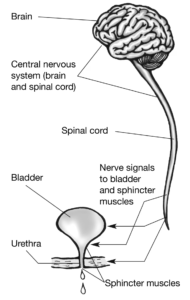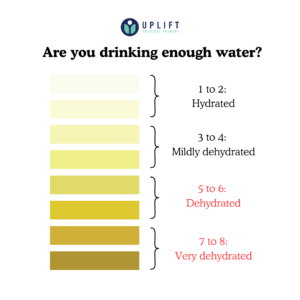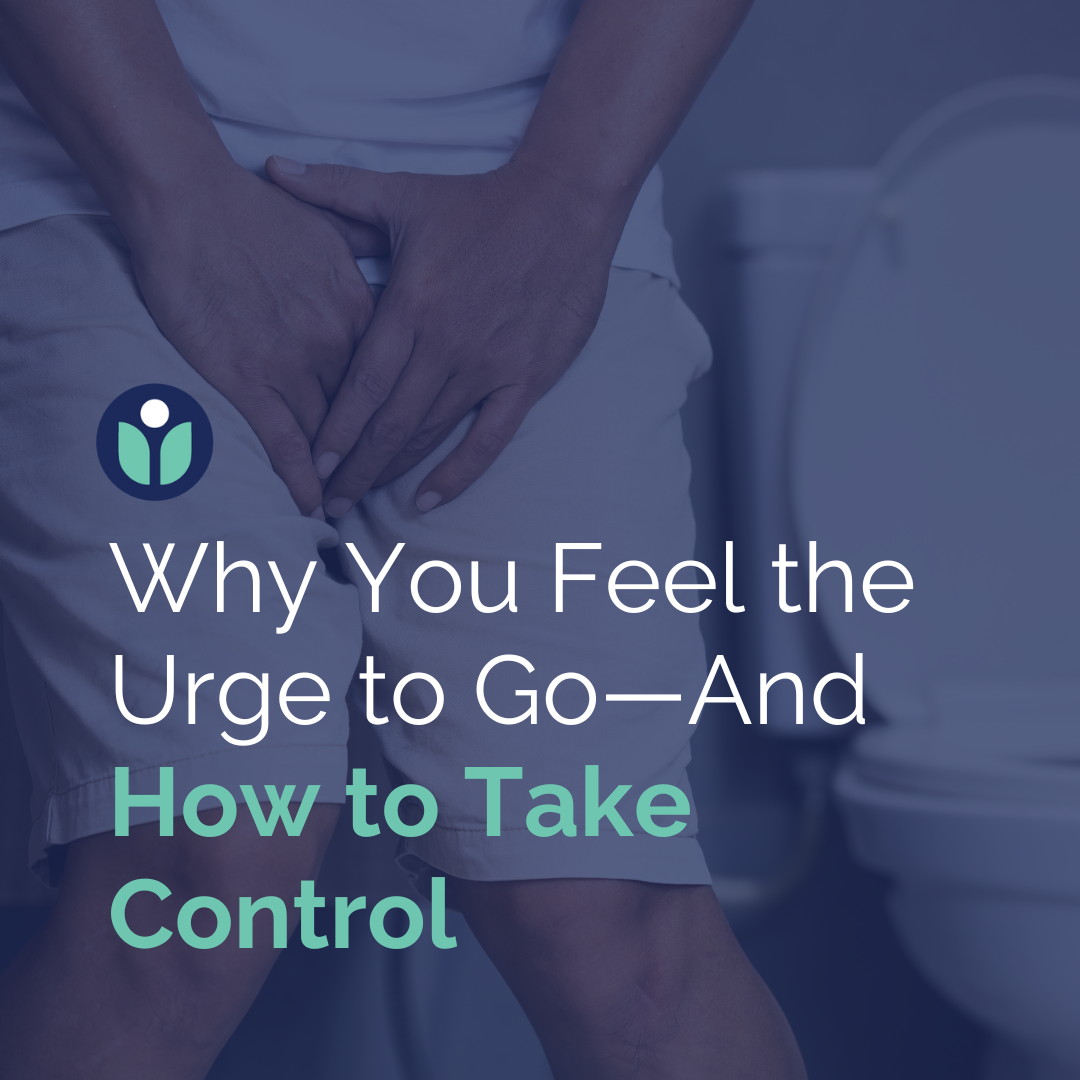Why You Feel the Urge to Go—And How to Take Control
Why You Feel the Urge to Go—And How to Take Control
Have you ever found yourself:
- Racing to the bathroom the moment you step in the door?
- Mapping out every restroom location before leaving the house?
- Cutting conversations short or excusing yourself suddenly because of a sudden, intense urge to pee?
- Having to stop mid-activity (workouts, meetings, social events) to rush to the restroom?
- Feeling like you can’t get your pants down fast enough once you reach the bathroom?
If any of these sound familiar, you’re definitely not alone! Many people experience a sudden, often overwhelming urge to urinate in these situations. Urinary urgency can show up in different ways for different people. But for those who live with it regularly, it’s no laughing matter—it can feel like you’re just a step away from not making it in time! This can be frustrating, embarrassing, and even disruptive to your daily life.
The good news is that by recognizing your triggers and making a few adjustments, you can take back control over this urge and start feeling more confident.
Understanding the Brain-to-Bladder Connection

Did you know your brain plays a key role in bladder function? This diagram shows how the nervous system helps control when and how your bladder empties.
To understand how to manage urge incontinence, we must first comprehend the brain-bladder connection.
Our brain and bladder are in constant communication through the nervous system. The brain sends signals to the bladder to store urine and then lets it know when it’s appropriate to release. The keyword here is “appropriate.” This connection is similar to a “permission system”—for example, many people find it nearly impossible to pee in front of a stranger because the brain tells the bladder to wait until it’s in a safe, private place.
In cases of urgency, however, this communication can become a bit too sensitive. The bladder functions like a balloon, stretching as it fills with urine. As it stretches, nerves send signals to the brain, alerting us that it’s time to go. But when these signals become disrupted or hypersensitive, it can lead to sudden, intense urges, even if the bladder isn’t actually full.
For some, hearing running water might be all it takes to trigger this urge; for others, just getting home seems to cue the bladder to demand immediate relief. These experiences aren’t unusual but can be incredibly frustrating.
Techniques for Managing Urinary Urgency
Managing urgency often requires some strategic changes to daily habits. Here are a few evidence-based techniques you can try:
1. Scheduled Voiding
Scheduled voiding means setting a regular interval for bathroom visits and gradually increasing it. Start by visiting the bathroom every 2–4 hours, depending on your water intake, and avoid going more than once per hour. If you find yourself going more frequently, try to stretch the time to 1.5 hours, then slowly increase your time as your bladder adjusts.
2. Delayed Urination
When you feel the urge, try delaying it for a few minutes rather than heading straight to the bathroom. Start with a short delay, and as you become more comfortable, gradually increase it. This technique helps retrain the brain-bladder connection, building up your tolerance for “holding it” a bit longer.
3. Relaxation Techniques
In the moment of an intense urge, we tend to tense up. This can heighten anxiety and increase the body’s natural response to evacuate the bladder. Ironically, tensing also increases pressure in the bladder, which can make the urge worse.
Instead, try to relax your pelvic floor muscles and take a deep breath. Imagine filling your abdomen like a balloon, then gently exhale while keeping the pelvic floor relaxed. Some people find that visualizing “blowing out birthday candles” or blowing up a balloon helps. Practicing this at home first can help you feel more confident using it when out and about.
4. Distraction Techniques
When you feel an urge, try to distract yourself by focusing on something else—tidy up a room, read a book, or call a friend. Distraction can reduce the intensity of urges and help retrain your brain to let go of the urgency trigger.
Building Better Habits

Stay hydrated with this simple chart! Compare the color of your urine to assess if you’re getting enough water and keep your body feeling its best.
Urinary urgency is often about consistent, small adjustments. Here are a few other factors that may be contributing to urgency:
- Dietary Irritants: Foods and drinks like caffeine, alcohol, spicy foods, and acidic fruits and vegetables can irritate the bladder lining, increasing urgency. Consider cutting back on these to see if your symptoms improve.
- Hydration Patterns: Both overhydration and dehydration can worsen urgency. Aim to drink about 64 fl oz per day or half your body weight in ounces.
- Stress and Anxiety: High stress can amplify the sensation of needing to urinate. Techniques like diaphragmatic breathing can help keep you calm and reduce urgency.
- Bladder Habits: Frequent “just in case” bathroom trips can condition your bladder to signal urgency more often than needed. Try to avoid these trips and wait until you feel a strong urge.
Treatments of Urge Incontinence
If these techniques aren’t enough, additional treatments are available:
- Pelvic Floor Therapy: During an evaluation, a pelvic therapist may ask about your bowel and bladder habits, water intake, and diet. This includes a full-body assessment, potentially with an internal exam if you’re comfortable. Based on the findings, the therapist will provide a personalized plan that includes behavior modifications, exercises, and strategies to manage urgency in real life. One-on-one guidance and a personalized treatment plan can make all the difference!
- Medications: Options like anticholinergics and beta-3 agonists are available to help reduce bladder overactivity.
- Botox Injections: Injecting Botox into the bladder muscle can reduce involuntary contractions, providing relief for several months.
- Nerve Stimulation: Percutaneous tibial nerve stimulation or sacral neuromodulation can help regulate bladder signals to the brain.
If you’re interested in exploring other treatment options, such as medications, Botox injections, or nerve stimulation therapies, please consult your physician to discuss the best approach for your needs.
When to Seek Help
If you find urinary urgency is consistently impacting your life, it might be time to reach out to a healthcare provider. Urinary urgency and incontinence can be isolating and discouraging, but you don’t have to live with it. Pelvic floor therapists are here to help you understand your symptoms and get back to living with confidence.
It’s time to prioritize you—because you deserve relief and a higher quality of life.
If you have questions or would like to book a FREE 15-minute phone consultation to learn more, our team is ready to help. Click the link below!
https://link.srvcsndr.com/widget/booking/jjZlhXoKFYfoWsP6lmDY
Contact Us
UpLift Physical Therapy Website
Phone: 210-468-7398
Follow us on social media: Instagram @upliftptp

